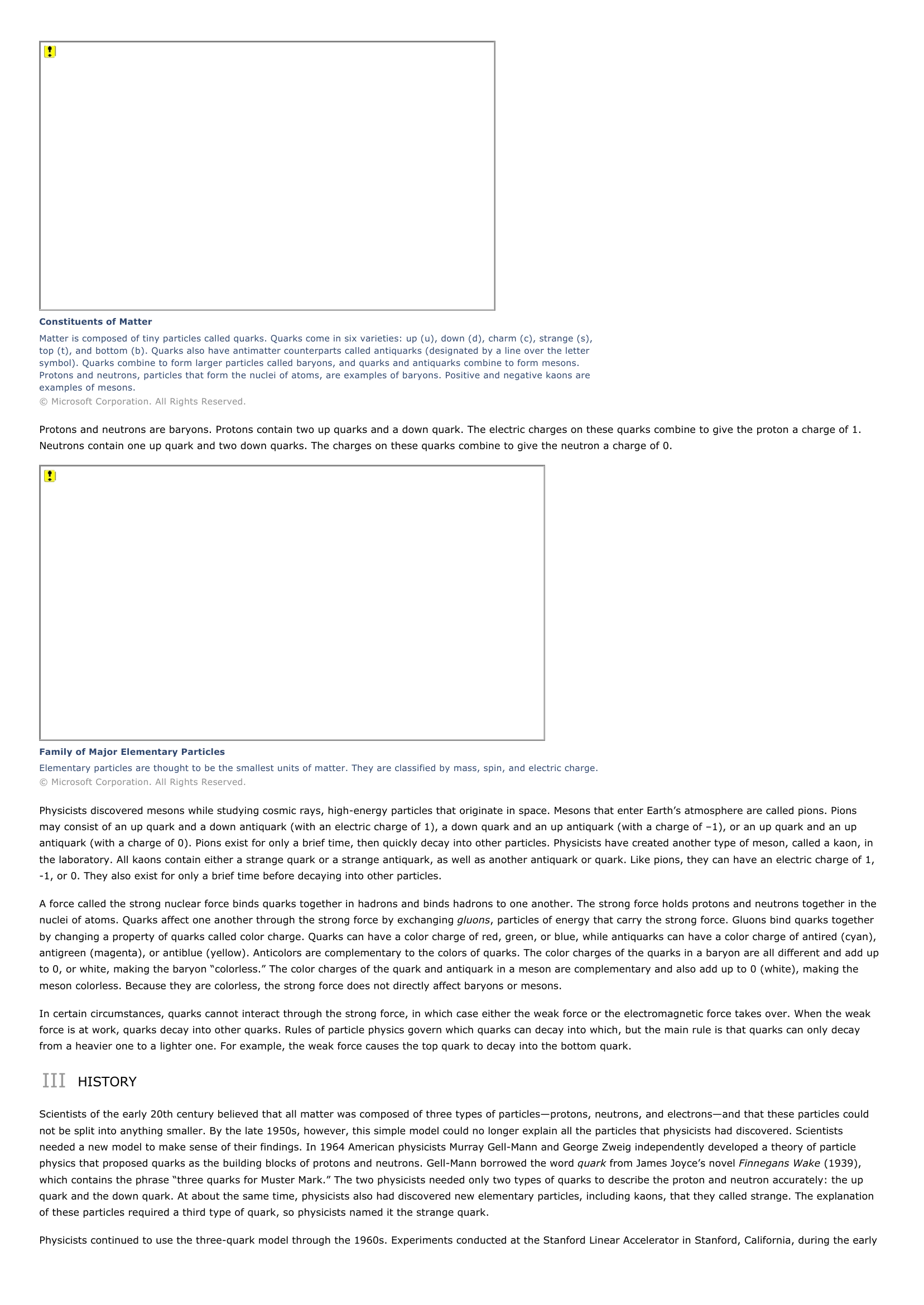Quark I INTRODUCTION Quark, smallest known building block of matter.
Publié le 12/05/2013

Extrait du document
«
Constituents of MatterMatter is composed of tiny particles called quarks.
Quarks come in six varieties: up (u), down (d), charm (c), strange (s),top (t), and bottom (b).
Quarks also have antimatter counterparts called antiquarks (designated by a line over the lettersymbol).
Quarks combine to form larger particles called baryons, and quarks and antiquarks combine to form mesons.Protons and neutrons, particles that form the nuclei of atoms, are examples of baryons.
Positive and negative kaons areexamples of mesons.© Microsoft Corporation.
All Rights Reserved.
Protons and neutrons are baryons.
Protons contain two up quarks and a down quark.
The electric charges on these quarks combine to give the proton a charge of 1.Neutrons contain one up quark and two down quarks.
The charges on these quarks combine to give the neutron a charge of 0.
Family of Major Elementary ParticlesElementary particles are thought to be the smallest units of matter.
They are classified by mass, spin, and electric charge.© Microsoft Corporation.
All Rights Reserved.
Physicists discovered mesons while studying cosmic rays, high-energy particles that originate in space.
Mesons that enter Earth’s atmosphere are called pions.
Pionsmay consist of an up quark and a down antiquark (with an electric charge of 1), a down quark and an up antiquark (with a charge of –1), or an up quark and an upantiquark (with a charge of 0).
Pions exist for only a brief time, then quickly decay into other particles.
Physicists have created another type of meson, called a kaon, inthe laboratory.
All kaons contain either a strange quark or a strange antiquark, as well as another antiquark or quark.
Like pions, they can have an electric charge of 1,-1, or 0.
They also exist for only a brief time before decaying into other particles.
A force called the strong nuclear force binds quarks together in hadrons and binds hadrons to one another.
The strong force holds protons and neutrons together in thenuclei of atoms.
Quarks affect one another through the strong force by exchanging gluons , particles of energy that carry the strong force.
Gluons bind quarks together by changing a property of quarks called color charge.
Quarks can have a color charge of red, green, or blue, while antiquarks can have a color charge of antired (cyan),antigreen (magenta), or antiblue (yellow).
Anticolors are complementary to the colors of quarks.
The color charges of the quarks in a baryon are all different and add upto 0, or white, making the baryon “colorless.” The color charges of the quark and antiquark in a meson are complementary and also add up to 0 (white), making themeson colorless.
Because they are colorless, the strong force does not directly affect baryons or mesons.
In certain circumstances, quarks cannot interact through the strong force, in which case either the weak force or the electromagnetic force takes over.
When the weakforce is at work, quarks decay into other quarks.
Rules of particle physics govern which quarks can decay into which, but the main rule is that quarks can only decayfrom a heavier one to a lighter one.
For example, the weak force causes the top quark to decay into the bottom quark.
III HISTORY
Scientists of the early 20th century believed that all matter was composed of three types of particles—protons, neutrons, and electrons—and that these particles couldnot be split into anything smaller.
By the late 1950s, however, this simple model could no longer explain all the particles that physicists had discovered.
Scientistsneeded a new model to make sense of their findings.
In 1964 American physicists Murray Gell-Mann and George Zweig independently developed a theory of particlephysics that proposed quarks as the building blocks of protons and neutrons.
Gell-Mann borrowed the word quark from James Joyce’s novel Finnegans Wake (1939), which contains the phrase “three quarks for Muster Mark.” The two physicists needed only two types of quarks to describe the proton and neutron accurately: the upquark and the down quark.
At about the same time, physicists also had discovered new elementary particles, including kaons, that they called strange.
The explanationof these particles required a third type of quark, so physicists named it the strange quark.
Physicists continued to use the three-quark model through the 1960s.
Experiments conducted at the Stanford Linear Accelerator in Stanford, California, during the early.
»
↓↓↓ APERÇU DU DOCUMENT ↓↓↓
Liens utiles
- Westerns I INTRODUCTION Gene Autry Known as the Singing Cowboy, Gene Autry was the star of nearly 100 Westerns during his career as an actor.
- Luciano PavarottiIINTRODUCTIONLuciano PavarottiRenowned Italian tenor Luciano Pavarotti was known for his mastery of the highest notes of a tenor's range and for hisjovial personality, which helped him earn a wide popular following.
- Acting I INTRODUCTION Lee Strasberg American acting teacher Lee Strasberg was best known for his association with the Actors Studio, of which he became the artistic director in 1951.
- Edgar Allan Poe I INTRODUCTION Edgar Allan Poe (1809-1849), American writer, known as a poet and critic but most famous as the first master of the short-story form (see Short Story), especially the psychological horror tale.
- Leonardo da Vinci I INTRODUCTION Leonardo da Vinci Leonardo da Vinci was known not only as a masterful painter but as an architect, sculptor, engineer, and scientist.













